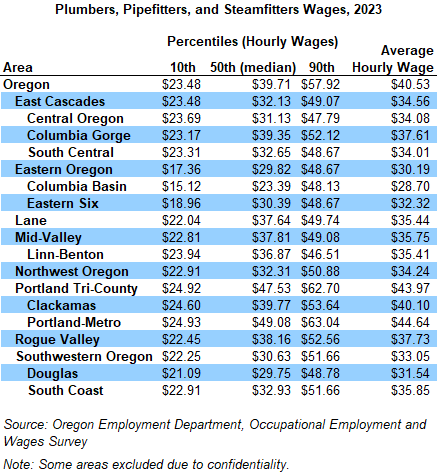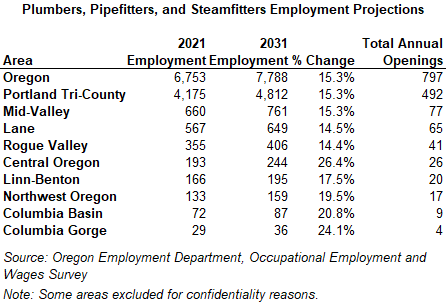Plumbers Can Find Top Wages in Oregon
October 11, 2023The effort to become a journey-level plumber is well rewarded in Oregon, as the average wage here is one of the highest in the nation for plumbers.
If you are considering a change in career paths, you may want to consider the plumbing trade. Journey-level plumbers complete home repairs, work on new commercial and residential construction, or work in manufacturing plants around the state.
Righty Tighty, Lefty Loosey!
Plumbers assemble, install, alter, and repair pipelines or pipe systems that carry water, steam, air, or other liquids or gases. They may install heating and cooling equipment and mechanical control systems.
Working conditions can vary depending on the job and industry. Plumbers might use hand and power tools or welding or soldering equipment depending on what work is needed. Plumbers need a combination of strength and stamina as the work may require lifting heavy pipes, fitting into uncomfortable or sometimes cramped locations, and being able to stand for long periods of time. Plumbers can also be exposed to all kinds of weather, especially in Oregon, as their work may take them outdoors.
What Do Plumbers Earn?
According to the Bureau of Labor Statistics (BLS), Oregon plumbers had the sixth highest average wage for plumbers, pipefitters, and steamfitters in the nation in 2022. The Oregon Employment Department estimates half of all Oregon plumbers, pipefitters, and steamfitters earned more than $39.71 per hour in 2023.

Job Security Is as Close as the Nearest Leaky Faucet
Plumbers can be found working in a number of industries. In 2023, about 80% of Oregon plumbers were employed in the construction industry, with most employed by building equipment contractors. Plumbers also work in utilities, manufacturing, educational services, and local government.
Plumbers are often their own boss. The rate of self-employment is notably higher than the rate for other occupations. In 2022, the BLS estimates that nationwide about 9.6% of plumbers were self-employed, compared with an estimated 6.0% of all occupations being self-employed.
According to the Oregon Employment Department there were 6,753 plumbers in Oregon in 2021. The downturn in construction beginning in 2008 was historic. Construction employment fell to levels we hadn’t seen since 2000. The construction industry reached and moved beyond its prior peak in 2018, and plumber employment has followed the economic trends upward.

The Oregon Employment Department estimates plumber employment will increase 15.3% from 2021 to 2031, about the average growth rate across occupations. It is projected that 104 annual openings in the occupation will become available due to job growth. An additional 693 annual openings will be due to plumbers leaving the trade, either through job switching, exiting the labor force, or retiring.
How to Become a Plumber
Becoming a plumber typically involves getting a state plumber’s license by completing an apprenticeship. Applicants to apprenticeship programs must first meet the minimum qualifications. The state requires applicants to provide proof of high school graduation or GED equivalent, and the applicant must be 18 years of age or older. Local apprenticeship committees oversee the apprenticeship and may have additional minimum requirements such as achieving certain math placement test results.
A plumber’s apprenticeship typically lasts four to five years. Apprentices start out earning 40% to 50% of what their journey-level counterparts make. Depending on progress in the program, wages can increase every six months. The apprenticeship includes between 7,700 and 8,000 hours of on-the-job training. It also includes a minimum of 144 hours of related classroom instruction each year of the apprenticeship. Instruction topics include service and repair, water system installation, blueprint and drawing training, and Oregon OSHA safety regulations for construction.
More information about apprenticeships and local committee requirements can be found at the Bureau of Labor and Industries Apprenticeship Division website at www.oregon.gov/BOLI/ATD and often on your local community college’s website.
As long as factories need pipe systems installed and maintained, or homes need plumbing systems repaired and built, there will be a need for plumbers. With high wages and many job openings expected to replace retiring workers, this field is a good bet for workers looking to develop their career in a hands-on, high-skill job.